Experimental and Numerical Investigations on High Performance SFRC: Cyclic Tensile Loading and Fatigue
Abstract
1. Introduction
2. Experimental Investigations
- Pull-out tests to assess the bond characteristics of individual steel fibers embedded in a high-strength mortar.
- The fatigue behavior of high-strength concrete with and without high-strength steel fibers under cyclic tension.
- The post-peak ductility and unloading/reloading behavior test performed on short steel fiber reinforced high-performance concrete (HPSFRC), assessed through the crack opening test with the predefined displacement-controlled loading scenario.
3. Materials and Methods
4. Test Methods
4.1. Pull-Out Tests
4.2. Static and Cyclic Tensile Tests
4.3. Crack Opening Tests
5. Numerical Model
5.1. Cohesive Zone Model for Concrete Cracking
5.2. Discrete Fiber Model
5.3. Finite Element Model of the Notched Fiber-Reinforced Prism Subjected to the Uniaxial Cyclic Load
6. Results and Discussion
6.1. Pull-Out Tests
6.2. Static and Cyclic Tensile Tests
6.3. Crack Opening Tests
7. Conclusions
- The cyclic tests showed that the rate of strain increase was lower for HPSFRC specimens and that the strain stagnated after around 10,000 cycles, which was not the case with HPC specimens.
- The microscopic analysis shows that the number of cracks increased continuously throughout the cyclic tests. In the case of high-strength concrete without short steel fibers (HPC-08), wider and longer cracks and thus a larger total crack area was found. In the HPC-08-SF, overall, more cracks were found, but these were smaller and shorter, i.e., more finely distributed so that the total crack area was smaller than in case of HPC-08.
- More than 66% of the microcracks run or start in the contact zone between the aggregate and the hardened cement stone (ITZ).
- The controlled crack opening tests were conducted to investigate the post-cracking behavior of short steel fiber reinforced concrete (HPC-08). The experiments have shown, and the numerical simulations have confirmed that the addition of short steel fibers had a minimal influence on the tensile strength, but the fibers significantly improved the ductility. The unloading stiffness after cracking is slightly lower than the initial (elastic) stiffness; however, it remains stable during the rest of the experiment, even under large crack openings. During unloading/reloading cycles, only a small hysteresis loop is formed, which, together with relatively stable unloading stiffness, indicated that the fibers carried the majority of the load. The dissipation due to frictional sliding of fibers manifested itself in the formation of the small hysteresis on the response diagram.
Author Contributions
Funding
Institutional Review Board Statement
Informed Consent Statement
Data Availability Statement
Acknowledgments
Conflicts of Interest
References
- Hegger, J.; Roggendorf, T.; Goralski, C.; Roeser, W. Ermüdungsverhalten von Beton unter Zyklischer Beanspruchung aus dem Betrieb von Windkraftanlagen; Deutsches Institut für Bautechnik (DIBt), Fraunhofer IRB Verlag: Stuttgart, Germany, 2012. [Google Scholar]
- Oneschkow, N.; von der Haar, C.; Hümmer, J.; Otto, C.; Lohaus, L.; Marx, S. Ermüdung von druckschwellbeanspruchtem Beton—Materialversagen, Modellbildung, Bemessung. In Beton-Kalender 2018—Bautenschutz, Brandschutz; Bergmeister, K., Fingerloss, F., Wörner, J., Eds.; Ernst & Sohn: Berlin, Germany, 2018. [Google Scholar]
- Dorys, C.G.; Moradillo, R.; Minguez, J.; Martinez, J.A.; Vicente, M.A. Postcracking residual strengths of fiber-reinforced high-performance concrete after cyclic loading. Struct. Concr. 2018, 19, 340–351. [Google Scholar]
- Thiele, M. Experimentelle Untersuchung und Analyse der Schädigungsevolution in Beton unter Hochzyklischen Ermüdungsbeanspruchungen. Ph.D. Thesis, BAM-Dissertationsreihe Berlin, Berlin, Germany, 2016. [Google Scholar]
- Kessler-Kramer, C. Zugtragverhalten von Beton unter Ermüdungsbeanspruchung. Ph.D. Thesis, Karlsruhe Institute for Technology, Karlsruhe, Germany, 2002. [Google Scholar]
- Fitik, B. Ermüdungsverhalten von Ultrahochfestem Beton (UHPC) bei Zyklischen Beanspruchungen im Druck-Zug-Wechselbereich. Ph.D. Thesis, Technische Universität München, München, Germany, 2012. [Google Scholar]
- Tue, N.V.; Mucha, S. Ermüdungsfestigkeit von hochfestem Beton unter Druckbeanspruchung. Bautechnik 2006, 7, 497–504. [Google Scholar] [CrossRef]
- Rings, K.-H. Unbewehrter und Bewehrter Beton unter Häufiger Wiederholter Wechselbeanspruchung. Ph.D. Thesis, Technische Hochschule Darmstadt, Darmstadt, Germany, 1986. [Google Scholar]
- Abdul-Razzak, A.A.; Mohammed Ali, A.A. Modelling and numerical simulation of high strength fibre reinforced concrete corbels. Appl. Math. Model. 2011, 35, 2901–2915. [Google Scholar] [CrossRef]
- Jansson, A.; Flansbjer, M.; Löfgren, I.; Lundgren, K.; Gylltoft, K. Experimental investigation of surface crack initiation, propagation and tension stiffening in self-compacting steel-fibre-reinforced concrete. Mater. Struct. Mater. Constr. 2012, 45, 1127–1143. [Google Scholar] [CrossRef]
- Yusof, M.A.; Nor, N.M.; Zain, M.F.M. Mechanical properties of hybrid steel fibre reinforced concrete with different aspect ratio. Aust. J. Basic Appl. Sci. 2011, 5, 159–166. [Google Scholar]
- Bhargava, P.; Sharma, U.K.; Kaushik, S.K. Compressive stress-strain behaviour of small scale steel fibre reinforced high strength concrete cylinders. J. Adv. Concr. Technol. 2006, 4, 109–121. [Google Scholar] [CrossRef][Green Version]
- Klyuev, S.V.; Klyuev, A.V.; Abakarov, A.D.; Shorstova, E.S.; Gafarova, N.G. The effect of particulate reinforcement on strength and deformation characteristics of fine-grained concrete. Mag. Civil Eng. 2017, 75, 66–75. [Google Scholar]
- Bentur, A.; Mindess, S. Fiber Reinforced Cementitous Composites; Elsevier Science Publishers: Amsterdam, The Netherlands, 1990; p. 449. [Google Scholar]
- Schäfer, N.; Breitenbücher, R. Pull—Out tests of carbon and high-strength steel microfibres in a cement-based matrix. In Proceedings of the fib Symposium, Krakow, Poland, 27–29 May 2019; Derkowski, W., Gwoździewicz, P., Hojdys, Ł., Krajewski, P., Pańtak, M., Eds.; fib: Laussane, Switzerland, 2019; pp. 1888–1895. [Google Scholar]
- Kützing, L. Bruchmechanischer Ansatz zur Tragfähigkeitsanalyse von Stahlfaserbeton. Beton Stahlbetonbau 2002, 97, 140–146. [Google Scholar] [CrossRef]
- Song, F. Steel Fiber Reinforced Concrete under Concentrated Load. Ph.D. Thesis, Ruhr-University Bochum, Bochum, Germany, 2017. [Google Scholar]
- Strack, M. Modellbildung Zum Rissbreitenabhängigen Tragverhalten von Stahlfaserbeton unter Biegebeanspruchung. Ph.D. Thesis, Ruhr-University Bochum, Bochum, Germany, 2007. [Google Scholar]
- Bergmeister, K.; Fingerloos, F. Beton-Kalender 2017: Spannbeton, Spezialbetone; Ernst & Sohn GmbH & Co. KG: Berlin, Germany, 2016. [Google Scholar]
- Bergmeister, K.; Fingerloos, F. Betonkalender 2018: Bautenschutz, Brandschutz. XII Ermüdung von Durckschwellbeanspruchtem Beton—Materialverhalten, Modellbildung, Bemessung; Ernst & Sohn GmbH & Co. KG: Berlin, Germany, 2017. [Google Scholar]
- Lanwer, J.P.; Oettel, V.; Empelmann, M.; Höper, S.; Kowalsky, U.; Dinkler, D. Bond behavior of micro steel fibers embedded in ultra-high-performance concrete subjected to monotonic and cyclic loading. Struct. Concr. 2019, 20, 1243–1253. [Google Scholar] [CrossRef]
- Schäfer, N.; Gudžulic, V.; Timothy, J.J.; Breitenbücher, R.; Meschke, G. Fatigue behavior of HPC and FRC under cyclic tensile loading: Experiments and modeling. Struct. Concr. 2019, 20, 1265–1278. [Google Scholar] [CrossRef]
- Rossi, P.; Tailhan, J.L. Numerical modeling of the cracking behavior of a steel fiber-reinforced concrete beam on grade. Struct. Concr. 2017, 18, 571–576. [Google Scholar] [CrossRef]
- Zhan, Y.; Meschke, G. Multilevel computational model for failure analysis of steel-fiber–reinforced concrete structures. J. Eng. Mech. 2016, 142, 04016090. [Google Scholar] [CrossRef]
- Kirane, K.; Bažant, Z.P. Microplane damage model for fatigue of quasibrittle materials: Sub-critical crack growth, lifetime and residual strength. Int. J. Fatigue 2015, 70, 93–105. [Google Scholar] [CrossRef]
- Vassaux, M.; Richard, B.; Ragueneau, F.; Millard, A. Regularised crack behaviour effects on continuum modelling of quasi-brittle materials under cyclic loading. Eng. Fract. Mech. 2015, 149, 18–36. [Google Scholar] [CrossRef]
- Sellier, A.; Casaux-Ginestet, G.; Buffo-Lacarriere, L.; Bourbon, X. Orthotropic damage coupled with localized crack reclosure processing. Part I: Constitutive laws. Eng. Fract. Mech. 2013, 97, 148–167. [Google Scholar] [CrossRef]
- Goudarzi, M.; Geijselaers, H.J.M.; Akkerman, R. Efficient analysis of dense fiber reinforcement using a reduced embedded formulation. Comput. Mech. 2021, 67, 1–15. [Google Scholar] [CrossRef]
- International Federation for Structural Concrete. Fib Model Code for Concrete Structures 2010; Ernst & Sohn: Berlin, Germany, 2013; pp. 102–103. [Google Scholar]
- Baktheer, A.; Chudoba, R. Classification and evaluation of phenomenological numerical models for concrete fatigue behavior under compression. Construct. Build. Mater. 2019, 221, 661–677. [Google Scholar] [CrossRef]
- Kirane, K.; Bažant, Z.P. Size effect in Paris law and fatigue lifetimes for quasibrittle materials: Modified theory, experiments and micro-modeling. Int. J. Fatigue 2016, 83, 209–220. [Google Scholar] [CrossRef]
- Van Mier, J.G.M. Concrete Fracture: A Multiscale Approach; CRC Press: Boca Raton, FL, USA, 2012. [Google Scholar]
- Suresh, S. Fatigue of Materials; Cambridge University Press: Cambridge, UK, 1998. [Google Scholar]
- Ritchie, R.O. Mechanisms of fatigue-crack propagation in ductile and brittle solids. Int. J. Fract. 1999, 100, 55–83. [Google Scholar] [CrossRef]
- Elber, W. Fatigue crack closure under cyclic tension. Eng. Fract. Mech. 1970, 2, 37–45. [Google Scholar]
- Snozzi, L.; Gatuingt, F.; Molinari, J.F. A meso-mechanical model for concrete under dynamic tensile and compressive loading. Int. J. Fract. 2012, 178, 179–194. [Google Scholar] [CrossRef]
- Snozzi, L.; Molinari, J.F. A cohesive element model for mixed mode loading with frictional contact capability. Int. J. Numer. Methods Eng. 2013, 93, 510–526. [Google Scholar] [CrossRef]
- Gudzulic, V.; Meschke, G. Multi-level approach for modelling the post-cracking response of steel fibre reinforced concrete under monotonic and cyclic loading. Proc. Appl. Math. Mech. 2021, in press. [Google Scholar]
- Richard, B.; Ragueneau, F.; Cremona, C.; Adelaide, L. Isotropic continuum damage mechanics for concrete under cyclic loading: Stiffness recovery, inelastic strains and frictional sliding. Eng. Fract. Mech. 2010, 77, 1203–1223. [Google Scholar] [CrossRef]
- Felippa, C.A. Introduction to Finite Element Methods; University of Colorado Boulder: Boulder, CO, USA, 2004. [Google Scholar]
- Breitenbücher, R.; Meschke, G.; Song, F.; Zhan, Y. Experimental, analytical and numerical analysis of the pullout behaviour of steel fibres considering different fibre types, inclinatons ans concrete strengths. Struct. Concr. 2014, 15, 126–135. [Google Scholar] [CrossRef]
- Gudžulic, V.; Neu, G.E.; Gebuhr, G.; Anders, S.; Meschke, G. Numerisches Mehrebenen-Modell für Stahlfaserbeton: Von der Faser-zur Bauteilebene: Mehrstufige Validierung anhand einer experimentellen Studie an hochfestem Faserbeton. Beton-und Stahlbetonbau 2020, 115, 146–157. [Google Scholar] [CrossRef]
- Zhan, Y.; Meschke, G. Analytical model for the pullout behavior of straight and hooked-end steel fibers. J. Eng. Mech. 2014, 140, 04014091. [Google Scholar] [CrossRef]
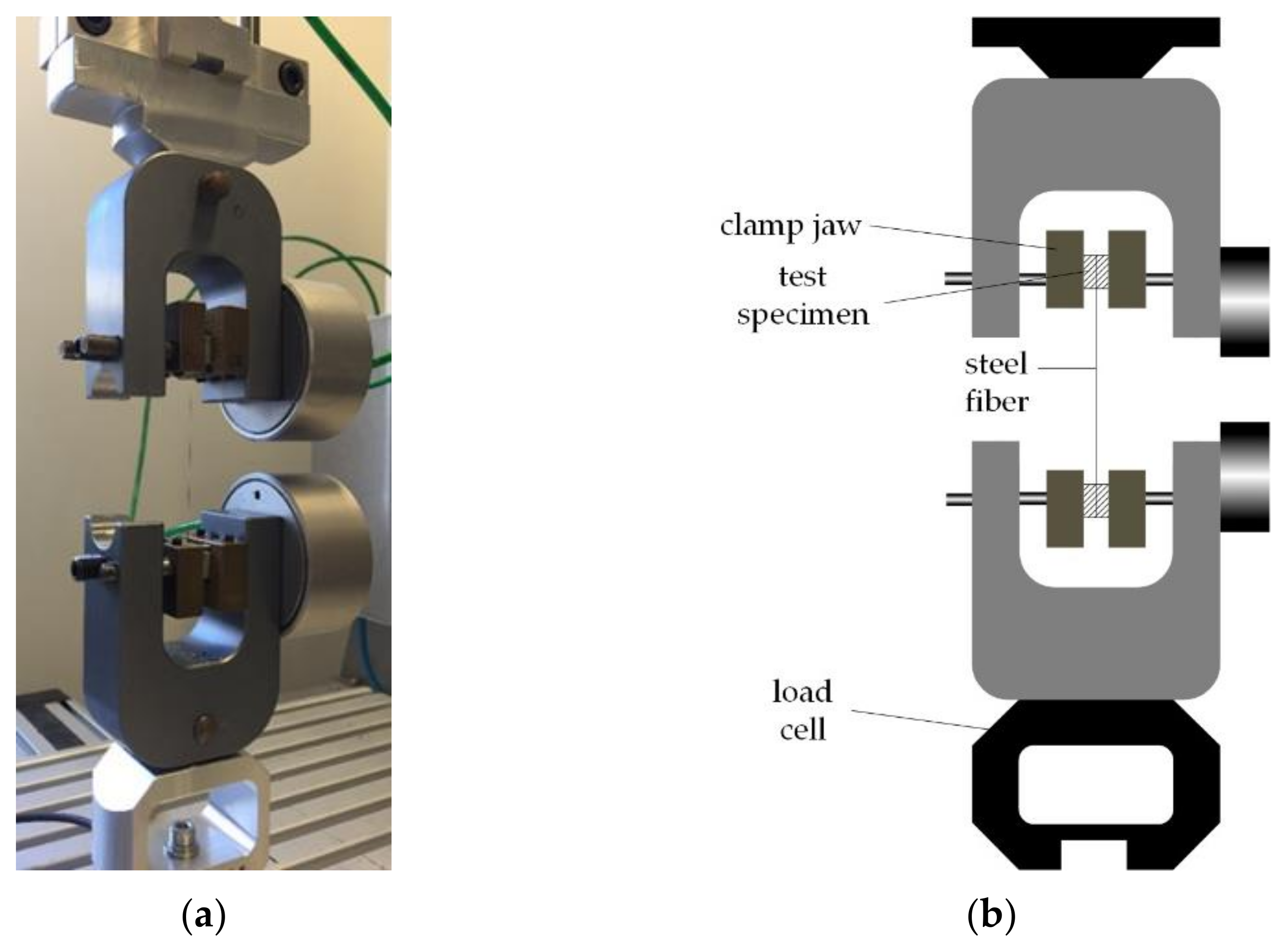
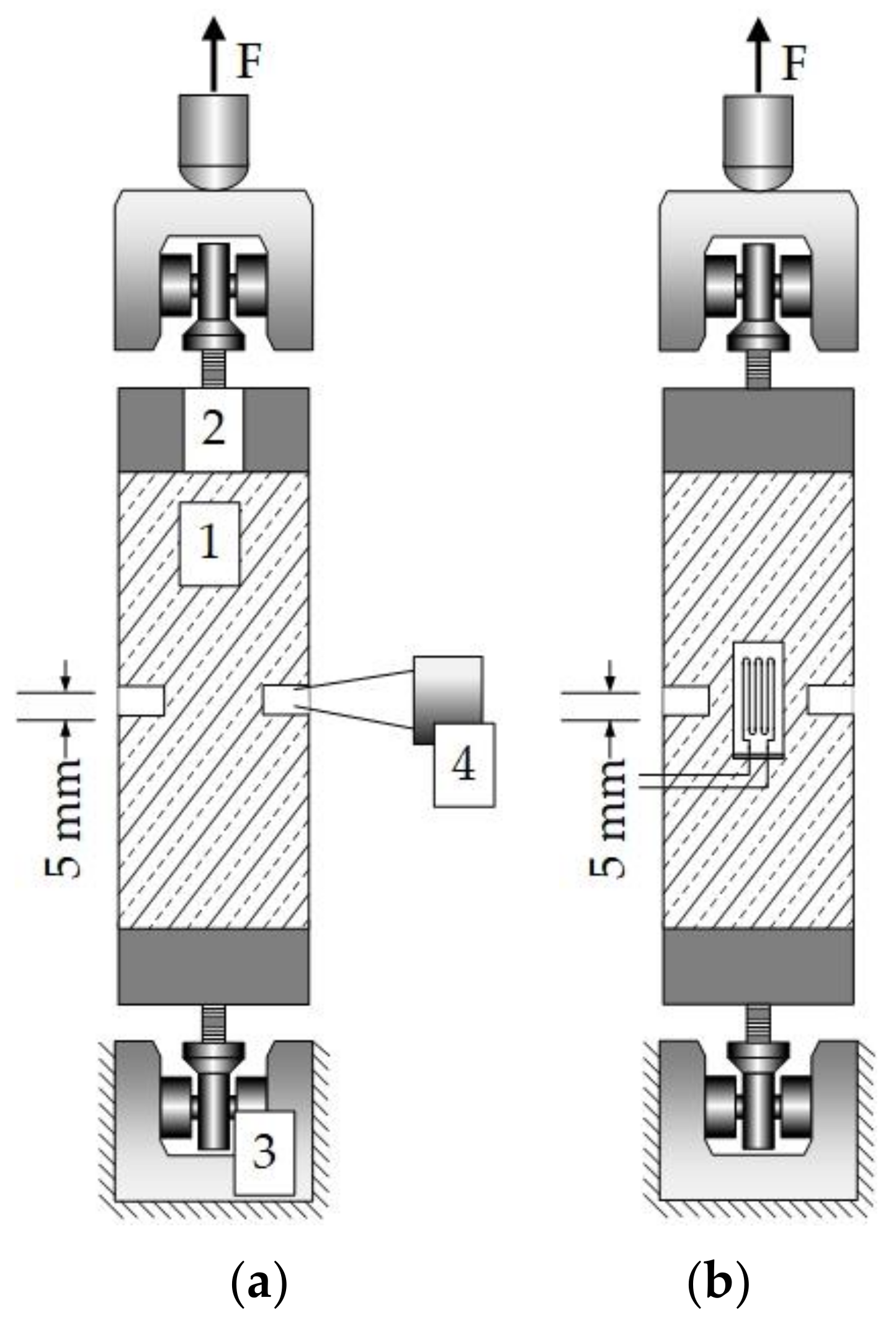

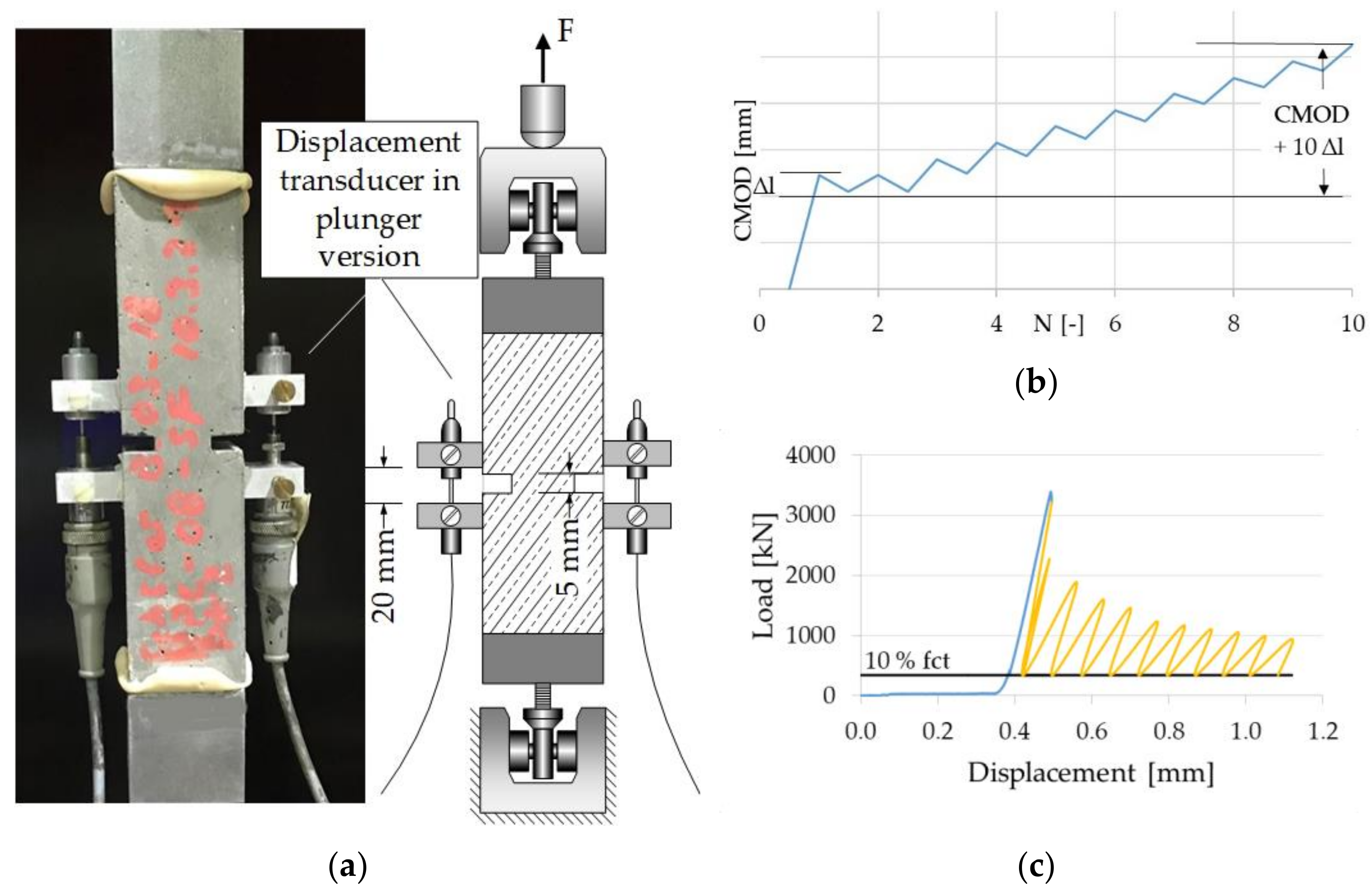

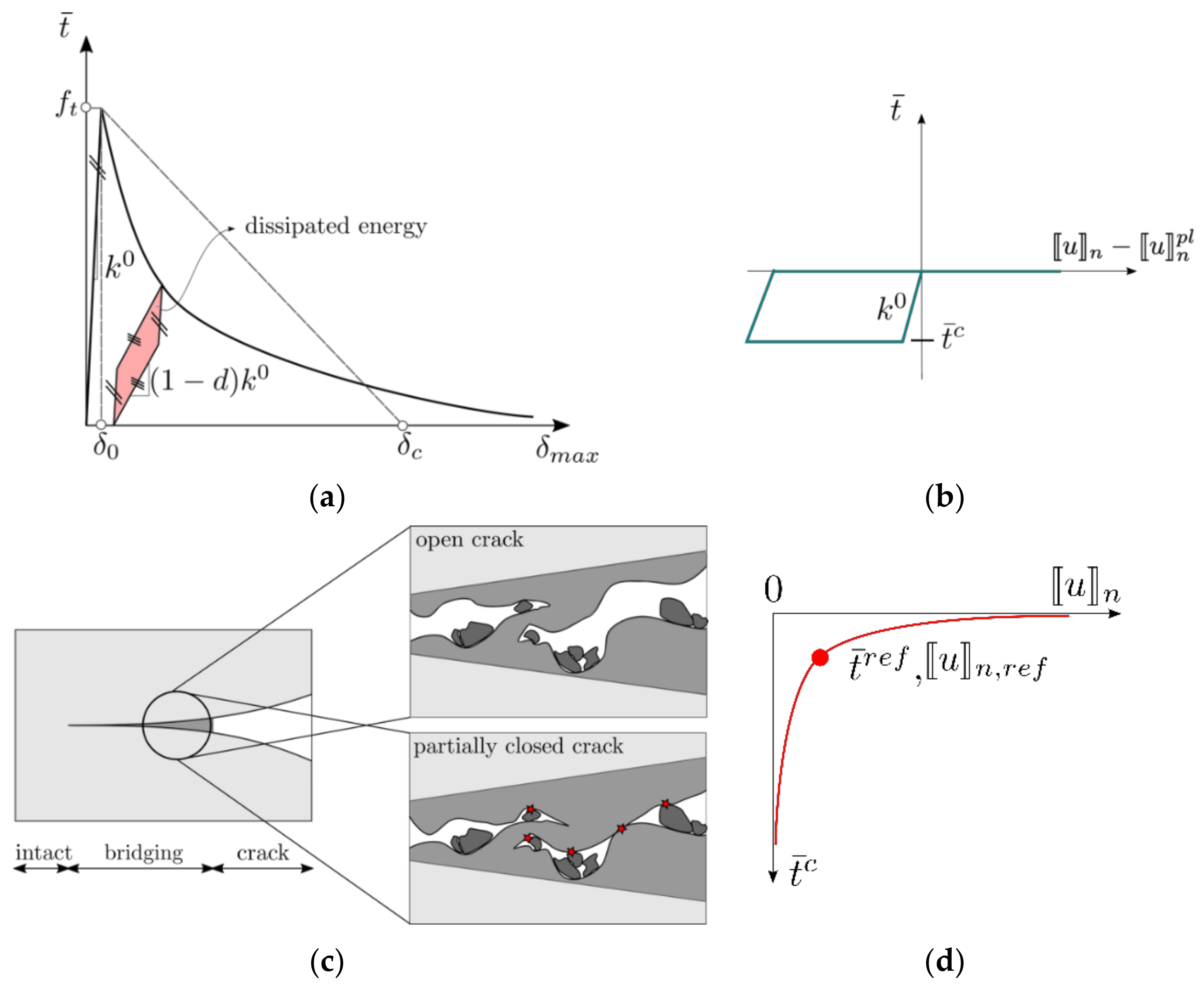
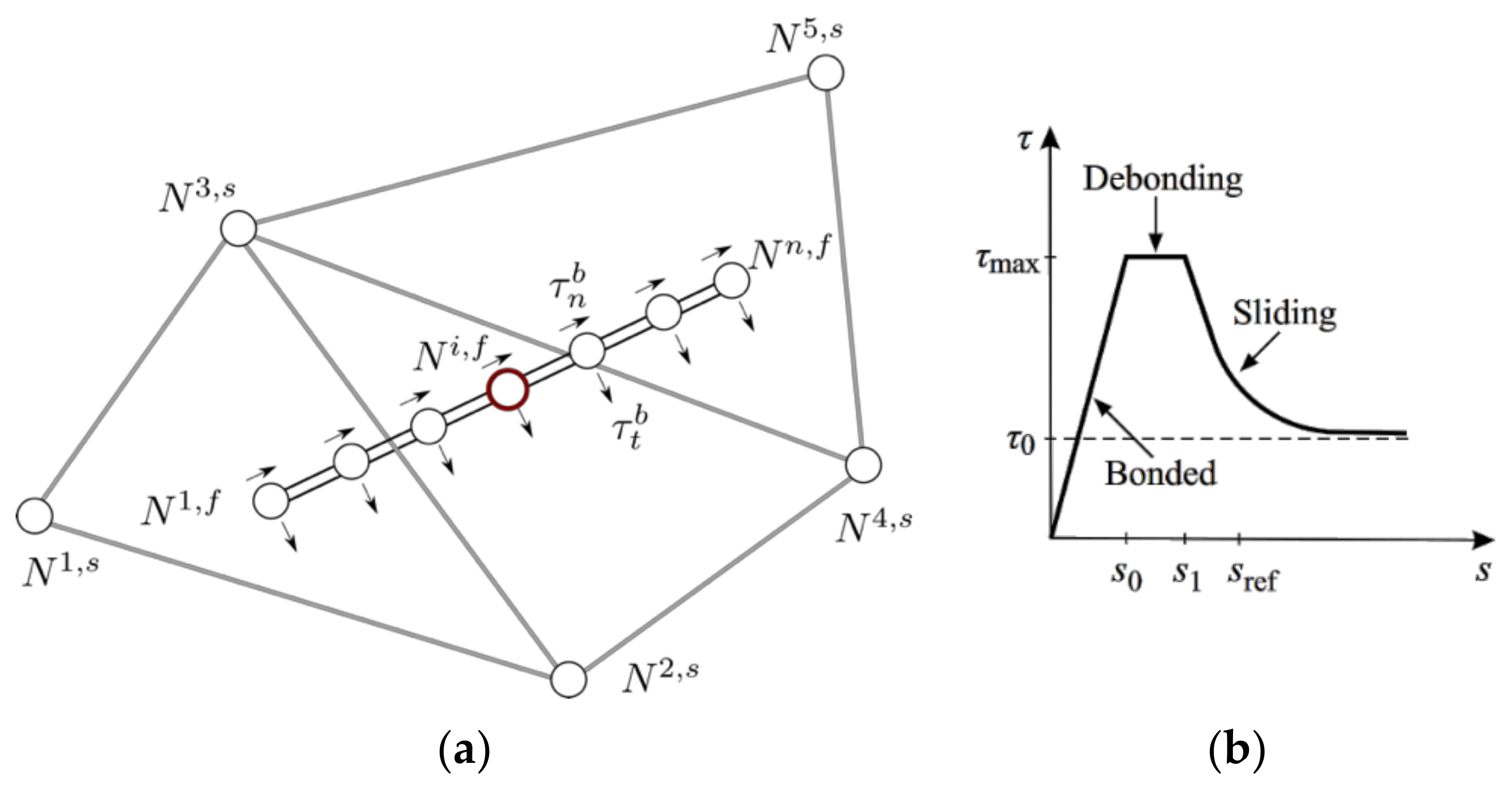

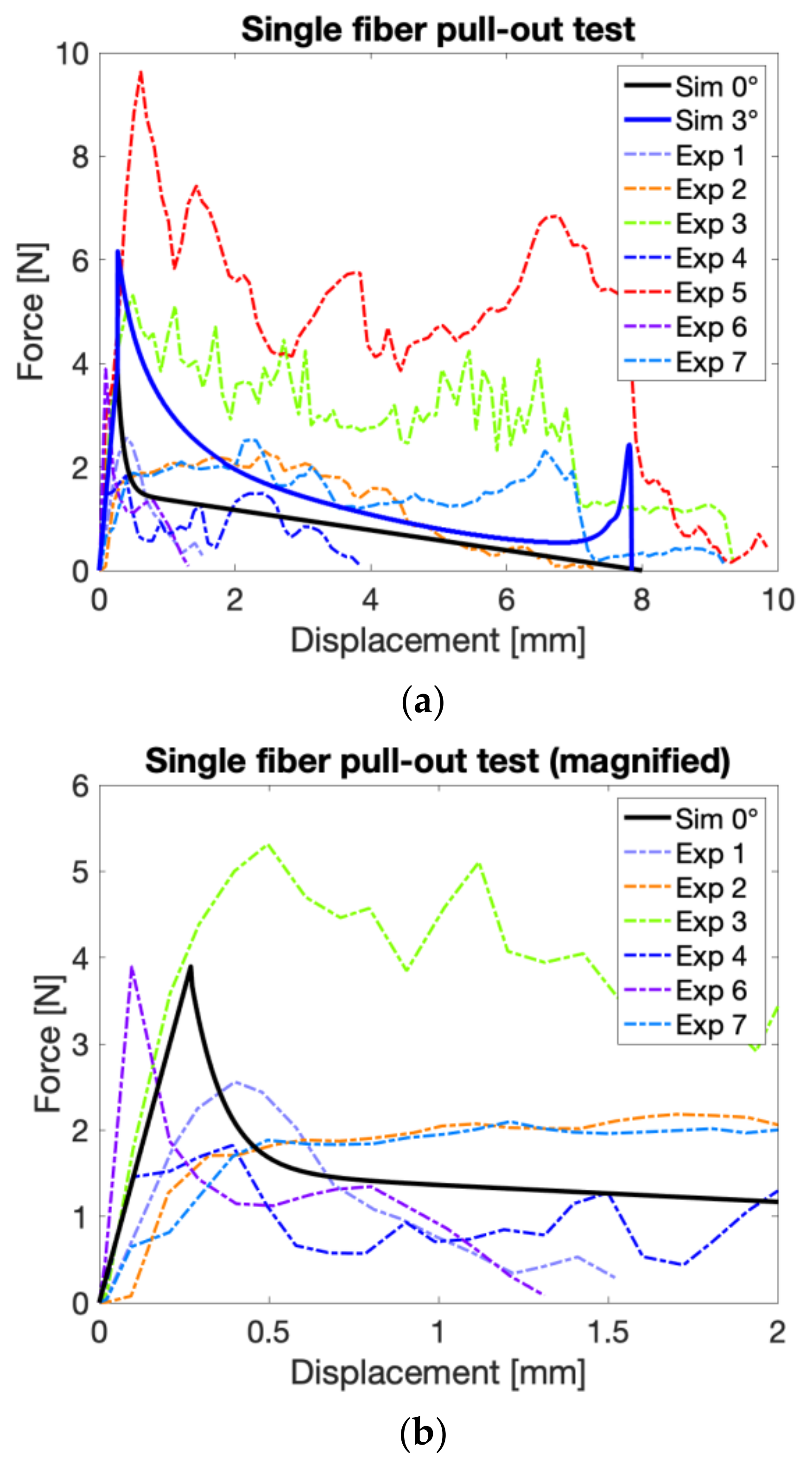
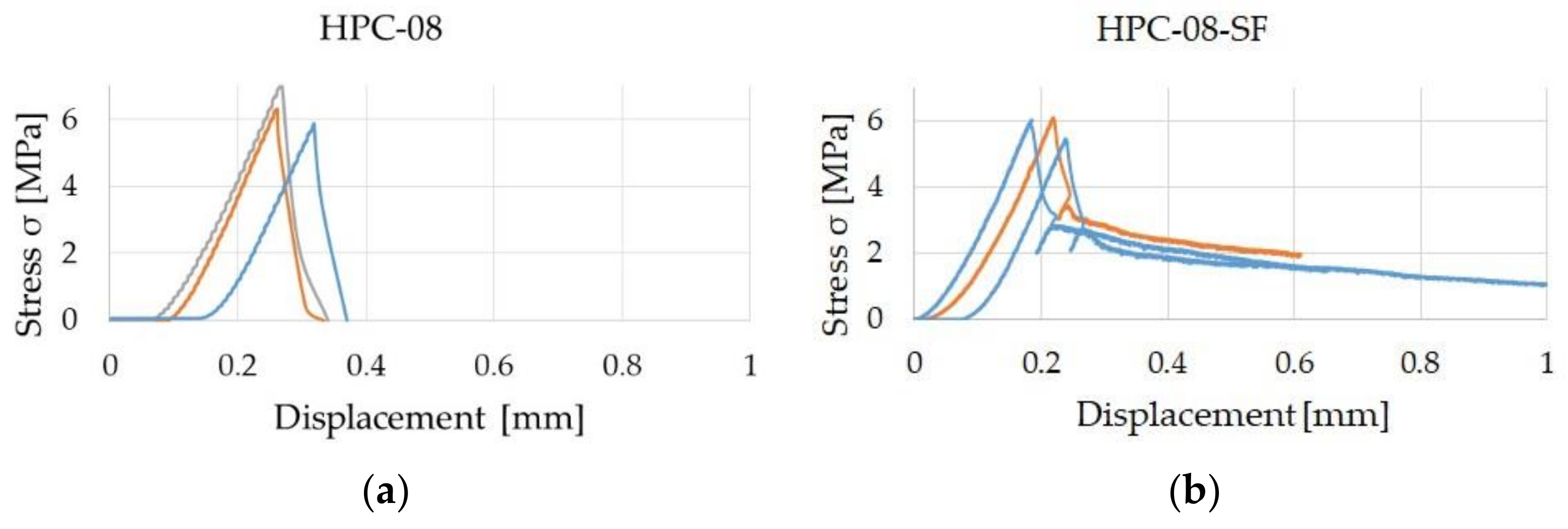
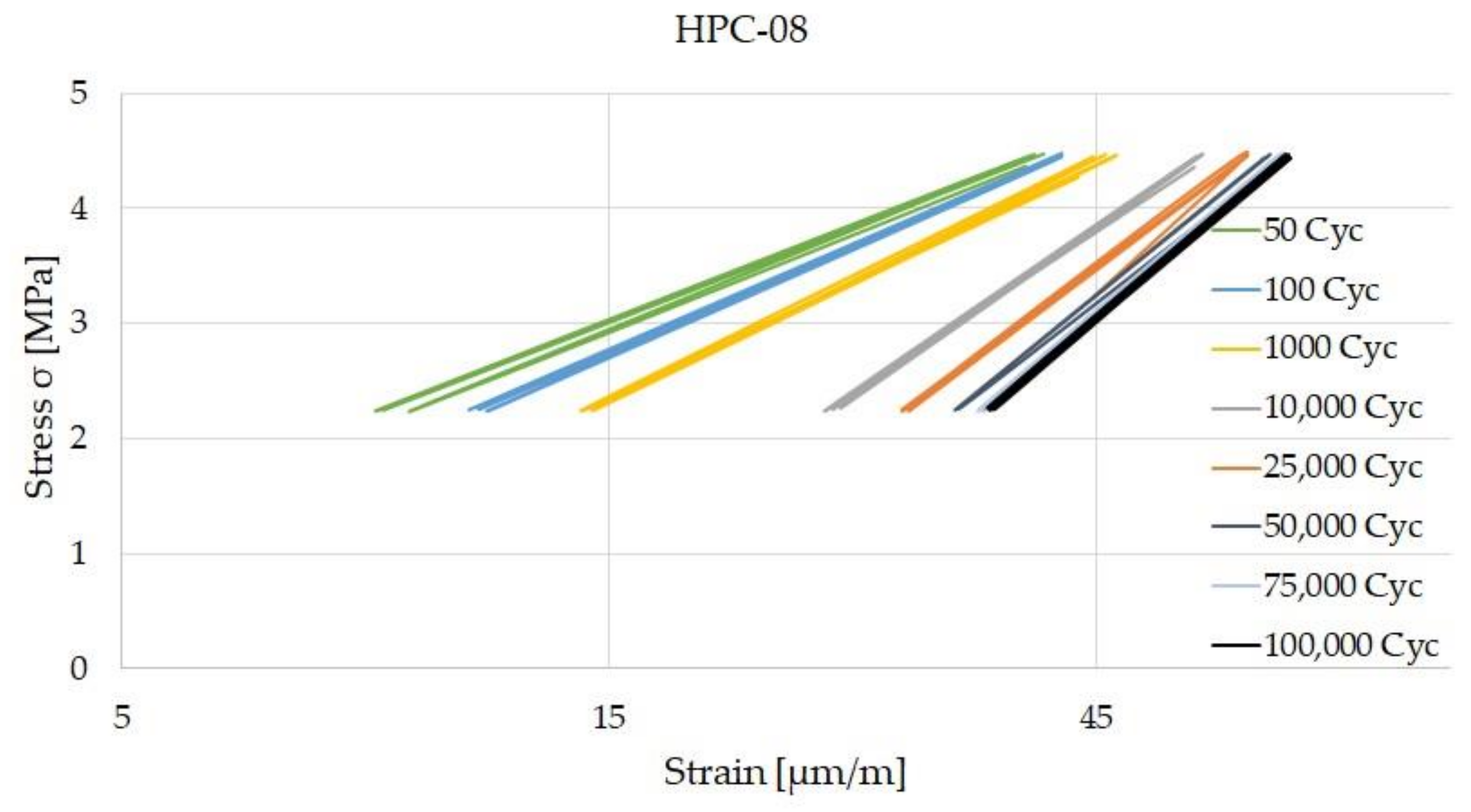


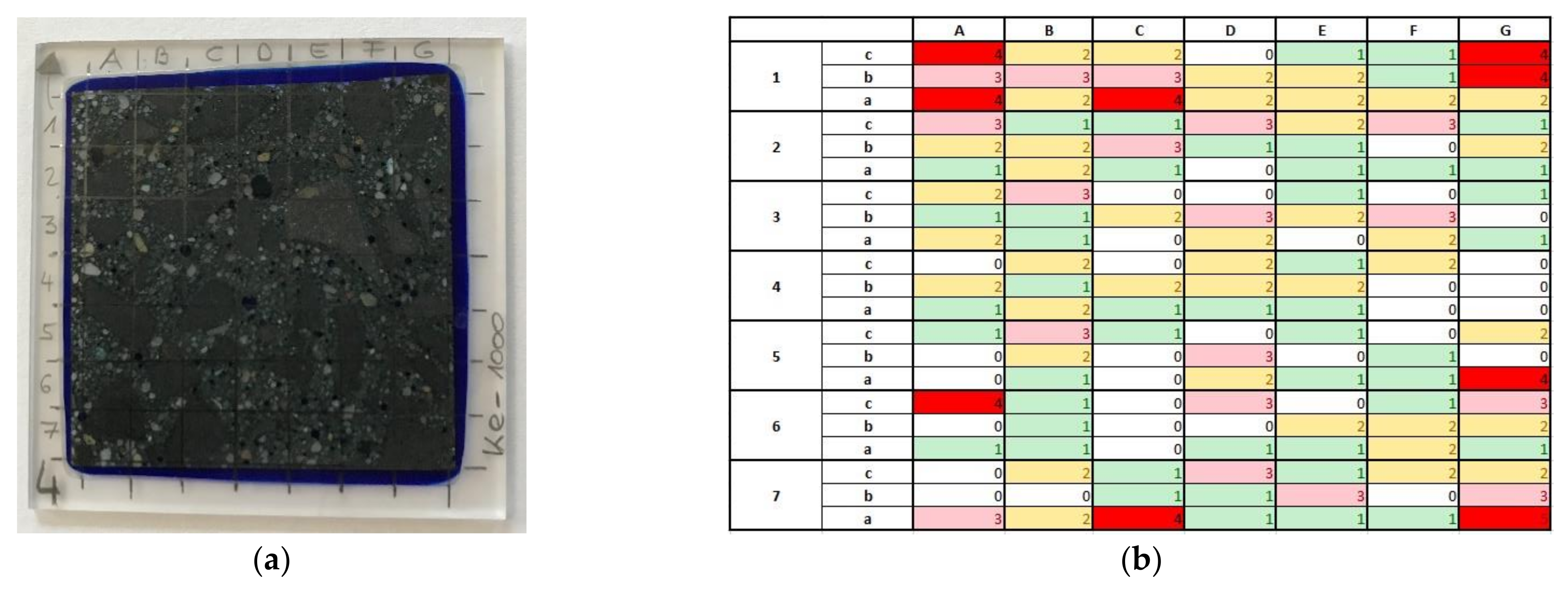

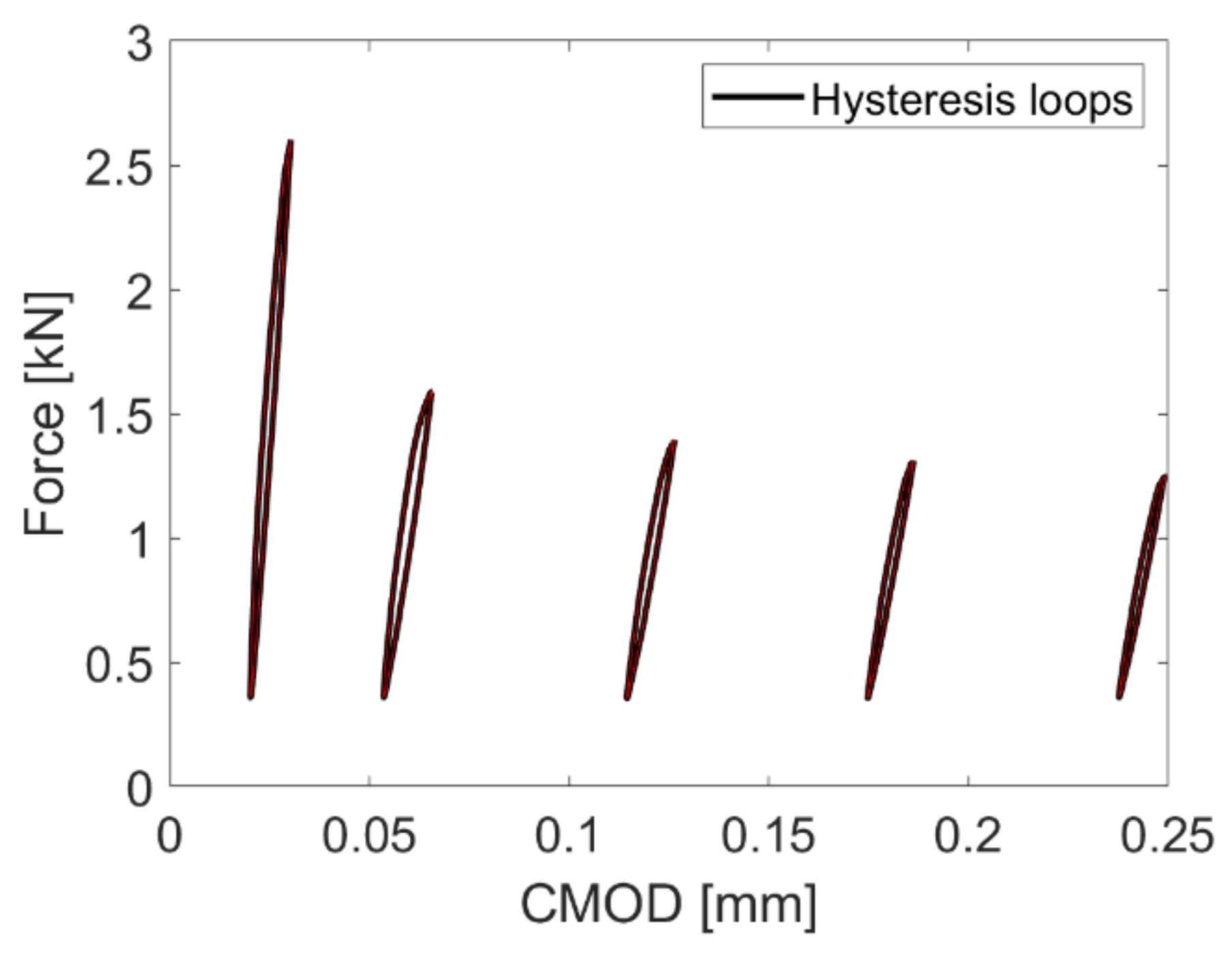
| Components | HPC-08 | HPC-08-SF | HPC-02 | |
|---|---|---|---|---|
| Cement | [kg/m3] | 500 | 500 | 646 |
| Sand 0/0.5 | [kg/m3] | 75 | 75 | 150 |
| Sand 0/2 | [kg/m3] | 850 | 850 | 1333 |
| Basalt 2/5 | [kg/m3] | 350 | 350 | - |
| Basalt 5/8 | [kg/m3] | 570 | 570 | - |
| Superplasticizer | [kg/m3] | 5.0 | 6.25 | 4.85 |
| Stabilizer | [kg/m3] | 2.85 | 3.55 | 2.76 |
| Water | [kg/m3] | 176 | 176 | 227.4 |
| Steel fibers | [kg/m3] | - | 78.5 | - |
| w/c | [-] | 0.35 | 0.35 | 0.35 |
| Material | Description | Brand | Length (mm) | Diameter (mm) | Tensile Strength (MPa) |
|---|---|---|---|---|---|
| Steel | Short fibers | Dramix OL 6/0.16 | 6 | 0.160 | 2600 |
| Steel | Long fiber | - | 250 | 0.155 | 2345 |
| Material Property | Value |
|---|---|
| Tensile strength (ft) [MPa] | 6.4 * |
| Compressive strength [MPa] | 109.0 * |
| Ratio of shear and tensile strength (β = fs/ft) [-] | 3.5 ** |
| Fracture energy in mode I (GF, I) [J/m2] | 100.0 * |
| Ratio of fracture energies in mode II and mode I (κ = GF, II/GF, I) [-] | 10 ** |
| Young’s modulus [MPa] | 43,224.4 * |
| Poisson’s ratio [-] | 0.2 * |
| Reference closure stress () [MPa] | 6.4 *** |
| Reference closure opening () [mm] | 0.4 *** |
| Composition | HPC-08 | HPC-08-SF | |
|---|---|---|---|
| Lower Load 35% fct,max | [kN] | 1.79 | 1.64 |
| Upper Load 70% fct,max | [kN] | 3.58 | 3.28 |
| Fiber Bond Properties | Value |
|---|---|
| τmax [MPa] | 1.0 |
| τ0 [MPa] | 0.4 |
| s0 [mm] | 0.001 |
| s1 [mm] | 0.001 |
| sref [mm] | 0.1 |
| Composition | HPC-08 | |||||
|---|---|---|---|---|---|---|
| Cycles | 0 | 1 | 100 | 1000 | 100,000 | |
| Number of cracks | [-] | 136 | 161 | 177 | 216 | 229 |
| Mean crack width | [µm] | 6.38 | 6.48 | 6.59 | 6.69 | 8.39 |
| Mean crack length | [µm] | 467 | 612 | 652 | 649 | 835 |
| Mean crack area | [µm2] | 3050 | 4030 | 4490 | 4510 | 7200 |
| Total crack area (35 × 35 mm2) | [µm2] | 414,484 | 648,357 | 795,573 | 974,455 | 1,649,470 |
| Composition | HPC-08-SF | |||||
|---|---|---|---|---|---|---|
| Cycles | 0 | 1 | 100 | 1000 | 100,000 | |
| Number of cracks | [-] | 145 | 182 | 218 | 244 | 302 |
| Mean crack width | [µm] | 5.18 | 4.69 | 4.55 | 4.20 | 5.39 |
| Mean crack length | [µm] | 421 | 457 | 447 | 540 | 511 |
| Mean crack area | [µm2] | 2230 | 2240 | 2070 | 2350 | 2870 |
| Total crack area (35 × 35 mm2) | [µm2] | 322,677 | 407,381 | 451,006 | 573,081 | 866,674 |
Publisher’s Note: MDPI stays neutral with regard to jurisdictional claims in published maps and institutional affiliations. |
© 2021 by the authors. Licensee MDPI, Basel, Switzerland. This article is an open access article distributed under the terms and conditions of the Creative Commons Attribution (CC BY) license (https://creativecommons.org/licenses/by/4.0/).
Share and Cite
Schäfer, N.; Gudžulić, V.; Breitenbücher, R.; Meschke, G. Experimental and Numerical Investigations on High Performance SFRC: Cyclic Tensile Loading and Fatigue. Materials 2021, 14, 7593. https://doi.org/10.3390/ma14247593
Schäfer N, Gudžulić V, Breitenbücher R, Meschke G. Experimental and Numerical Investigations on High Performance SFRC: Cyclic Tensile Loading and Fatigue. Materials. 2021; 14(24):7593. https://doi.org/10.3390/ma14247593
Chicago/Turabian StyleSchäfer, Niklas, Vladislav Gudžulić, Rolf Breitenbücher, and Günther Meschke. 2021. "Experimental and Numerical Investigations on High Performance SFRC: Cyclic Tensile Loading and Fatigue" Materials 14, no. 24: 7593. https://doi.org/10.3390/ma14247593
APA StyleSchäfer, N., Gudžulić, V., Breitenbücher, R., & Meschke, G. (2021). Experimental and Numerical Investigations on High Performance SFRC: Cyclic Tensile Loading and Fatigue. Materials, 14(24), 7593. https://doi.org/10.3390/ma14247593






